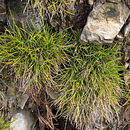Comments
provided by eFloras
Isolepis cernua is widespread and variable. Four varieties were recognized by A. M. Muasya and D. M. Simpson (2002). Only var. ceruna is known from North America. The earliest collection I have seen from the Pacific Coast is from 1888; the earliest collection I have seen from Texas is from 1974.
- license
- cc-by-nc-sa-3.0
- copyright
- Missouri Botanical Garden, 4344 Shaw Boulevard, St. Louis, MO, 63110 USA
Description
provided by eFloras
Plants annual (or perennial?); rhizomes usually obscured by culm bases and very short, sometimes vertical and elongated. Culms 4–40 cm × 0.2–0.5 mm. Leaves sometimes sparsely orange-punctate at 10–15X; sheaths usually reddish proximally; distal blade rudimentary to much longer than sheath, often exceeding culm, to 20 cm × 0.2–1 mm. Inflorescences: involucral bract 1, sometimes subtending flower or resembling enlarged floral scale, 2–6(–23) mm. Spikelets 2–5 × 1–2 mm; scales partly or completely dark orange to red-brown, rarely stramineous, midrib greenish to stramineous, not gibbous, obscurely to prominently 3–11-veined, midrib keeled near apex, membranous, hyaline, apex rounded to acute, with mucro less than 0.1 mm; proximal scale to 2 mm; other scales 1.2–1.8 × 1–1.3 mm. Flowers: anthers 0.3–0.6 mm; styles 3-fid or 3-fid and 2-fid. Achenes falling separately from scales, medium to dark brown or stramineous, ellipsoid to obovoid, compressed-trigonous to thickly biconvex, lateral angles usually prominent, abaxial angle prominent to obscure, faces convex or adaxial face slightly concave, 0.8–1 × 0.5–0.7 mm, distinctly papillose at 10–15X to obscurely papillose at 40X, often with thin whitish surface layer. 2n = 30.
- license
- cc-by-nc-sa-3.0
- copyright
- Missouri Botanical Garden, 4344 Shaw Boulevard, St. Louis, MO, 63110 USA
Distribution
provided by eFloras
B.C.; Calif., Oreg., Tex., Wash.; Mexico (Baja California); temperate South America; Eurasia; Africa; Australia; New Zealand.
- license
- cc-by-nc-sa-3.0
- copyright
- Missouri Botanical Garden, 4344 Shaw Boulevard, St. Louis, MO, 63110 USA
Flowering/Fruiting
provided by eFloras
Fruiting late spring–winter (Pacific Coast), winter–spring (Texas).
- license
- cc-by-nc-sa-3.0
- copyright
- Missouri Botanical Garden, 4344 Shaw Boulevard, St. Louis, MO, 63110 USA
Habitat
provided by eFloras
Wet, freshwater to brackish places on beaches, dunes, marine bluffs, sandy areas, mostly coastal; 0–800m.
- license
- cc-by-nc-sa-3.0
- copyright
- Missouri Botanical Garden, 4344 Shaw Boulevard, St. Louis, MO, 63110 USA
Synonym
provided by eFloras
Scirpus cernuus Vahl, Enum. Pl. 2: 245. 1805; S. cernuus var. californicus (Torrey) Beetle; S. cernuus subsp. californicus (Torrey) Thorne
- license
- cc-by-nc-sa-3.0
- copyright
- Missouri Botanical Garden, 4344 Shaw Boulevard, St. Louis, MO, 63110 USA
Derivation of specific name
provided by Flora of Zimbabwe
cernua: drooping, nodding
- license
- cc-by-nc
- copyright
- Mark Hyde, Bart Wursten and Petra Ballings
- bibliographic citation
- Hyde, M.A., Wursten, B.T. and Ballings, P. (2002-2014). Isolepis cernua (Vahl) Roem. & Schult. Flora of Zimbabwe website. Accessed 28 August 2014 at http://www.zimbabweflora.co.zw/speciesdata/species.php?species_id=110960
- author
- Mark Hyde
- author
- Bart Wursten
- author
- Petra Ballings
Isolepis cernua: Brief Summary
provided by wikipedia EN
Isolepis cernua (basionym Scirpus cernuus) is a species of flowering plant in the sedge family known by the common names low bulrush, slender club-rush, tufted clubrush, and fiberoptic grass. It is widespread, being native to many regions of the world, including parts of Australasia, Eurasia, Africa, and North and South America.
I. cernua is a small sedge that can be common in boggy ground and around ponds in both freshwater wetlands and salt marshes, as well as among dune slacks and other brackish environments.
- license
- cc-by-sa-3.0
- copyright
- Wikipedia authors and editors

